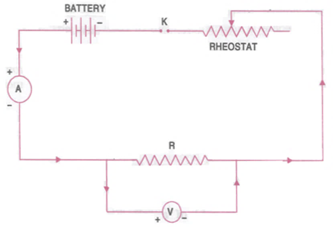State Ohm’s law? How can it be verified experimentally? Does it hold well under all conditions? Comment.
Ohm’s Law
Ohm’s law states that the current flowing through a conductor is directly proportional to the potential difference across the conductor. The proportionality constant is the resistance of the conductor; it is a constant for a known temperature range.
Verifying Experimentally:
1. Connect the wires as shown in the diagram.

2. Increase the rheostat to increase the current in the circuit.
3. Obtain the value of current in the circuit by the ammeter and also find the potential difference using the voltmeter.
4. For increase in current see the brightness of the bulb connected. Use your knowledge so far to obtain the resistance of the bulb.
Graph of Ohm’s law is a straight line obtained when current in the circuit (I) is plotted along x axis and potential (V) along y axis. The Graph obtained is shown in the figure below.

Conditions For Ohm’s Law to hold.
Ohm's law does not hold under all conditions.
1. Ohm's law does not hold for non-ohmic material such as electrolyte.
2. In varying temperature conditions ohm's law does not hold good.